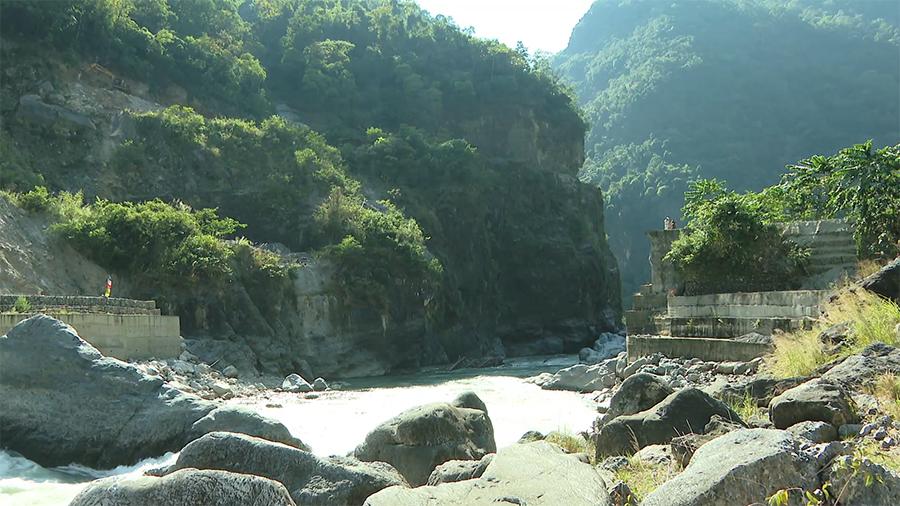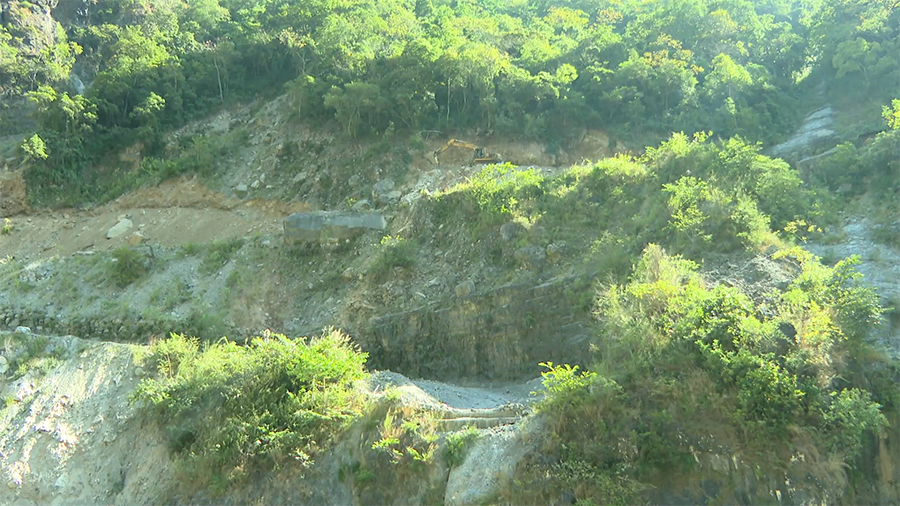
The work to reconstruct the Kuri-Gongri bridge is underway as business community, truckers, and travellers in the east await the launch of the modular bridge, almost six months after the bailey bridge collapsed. Currently, the realignment of the road near the bridge abutment towards the Nganglam side is in full swing. In the past, heavy vehicles faced difficulty climbing the steep road while travelling with heavy loads towards Nganglam. Without a bridge replacement, business community and truckers in the east claim that the increased cost of transportation is affecting their businesses.
 The road near the abutment towards Nganglam is quite steep making it difficult for vehicles, especially trucks travelling from Monggar towards Nganglam.
The road near the abutment towards Nganglam is quite steep making it difficult for vehicles, especially trucks travelling from Monggar towards Nganglam.
According to the Principal Engineer with the Department of Surface Transport in Nganglam, reducing the gradient of the road will improve the safety of travellers.
Excavation and road surface modification works are being carried out to level the road and reduce the steep slope.
Construction workers are aiming to complete the realignment within four to five months, which is about two months ahead of the deadline.
The work worth Nu 32 M has been awarded to a contractor.
Meanwhile, the Department of Surface Transport plans to launch the modular bridge over Kuri Gongri by next month.
“The bridge parts should be reaching the site by the end of December and then we will start the reconstruction from the first week of January. We are hoping to complete the bridge by the end of January and this time the material is of higher grade steel which will carry more load, that is up to 50 metric tons. So that’s why this will give a better hope for public transport,” said Kinzang Dorji, Chief Engineer of the Department of Surface and Transport in Lingmithang.
He added that the realignment works, repairing of abutments, and bridge construction were estimated to cost Nu 80 M.
Nganglam-Gyalpozhing highway is used by the residents and business owners of Monggar, Lhuentse, Trashigang and Trashi Yangtse.
“Without the bridge, our business remains affected. We already have to pay higher price when buying the goods from Phuntshogling. On top of that, we have to pay extra charges for the transportation,” said Karma Dorji, a shopkeeper.
“As we have to pay about 70 per cent extra for transportation charges, we would be grateful if the bridge is constructed sooner,” said Narmada Sharma, another shopkeeper.
“After the bridge collapsed, we are facing a lot of problems. We have to spend more when travelling via Samdrup Jongkhar. If we travel via Gyalpozhing-Nganglam highway, we reach Phuentshogling in a day. Now, it takes two days when we travel via Samdrup Jongkhar,” said Choney Norbu, who is also a shopkeeper.
“If we travel via Nganglam highway it costs about Nu 13,000 to 14,000. But when we have to travel via Samdrup Jongkhar, it costs about Nu 35,000 to 40,000 for the transportation charge,” said Karma Wangdi, a driver.
However, the Department of Surface Transport says alongside the road realignment work along the Nganglam highway, they are also carrying out minor road widening works along the Gyalposhing highway.
The bailey bridge which connects Gyalpozhing in Monggar and Nganglam in Pema Gatshel collapsed twice this year, in June and in May. The investigation report in August found out that the bridge collapsed due to overloading. The two trucks that got washed away after the bridge collapsed were found to be carrying about 40 metric tons of loads during the time of the incidents. The bailey bridge was designed to carry only 30 metric tons of loads.
Karma Wangdi and Thinley Dorji
Edited by Phub Gyem









